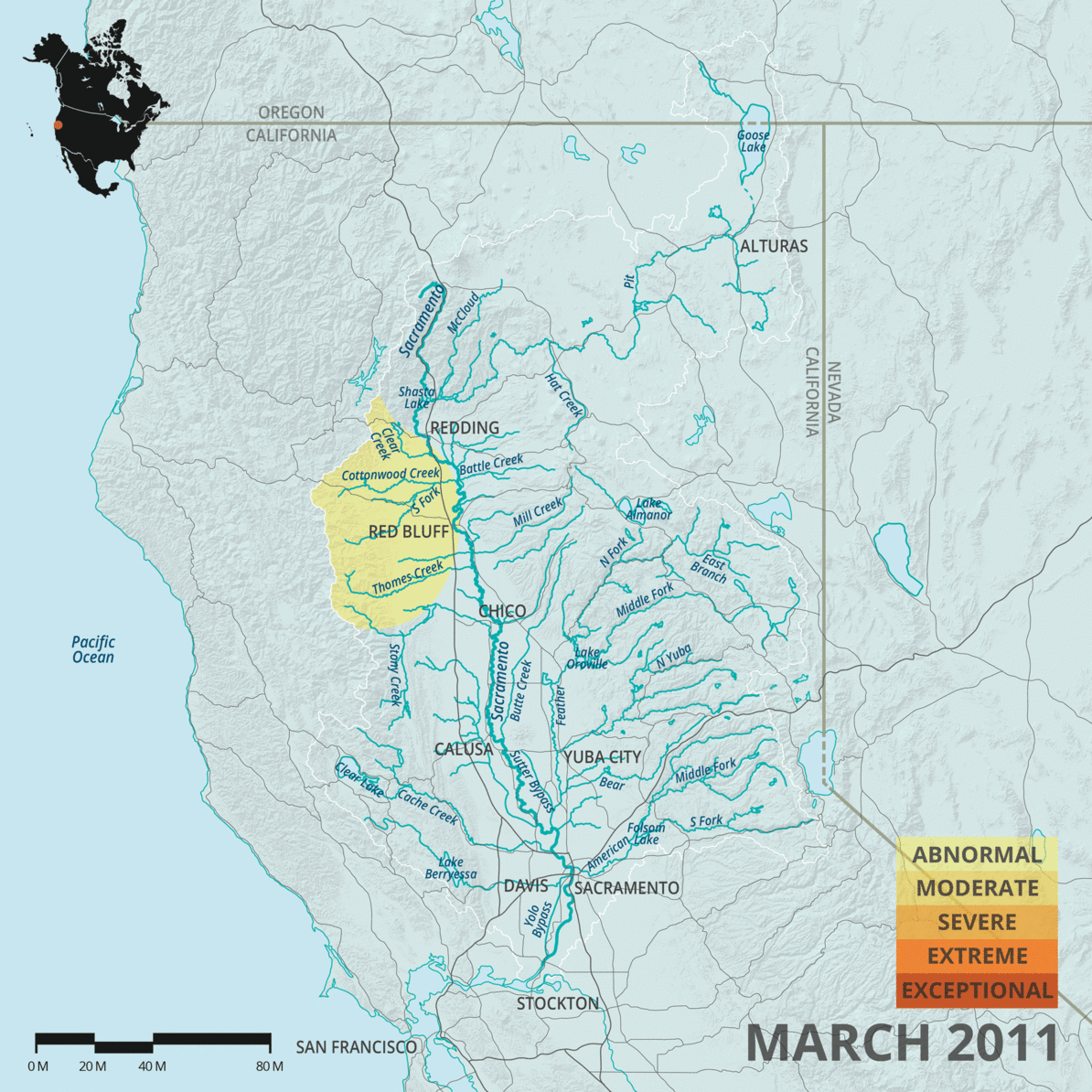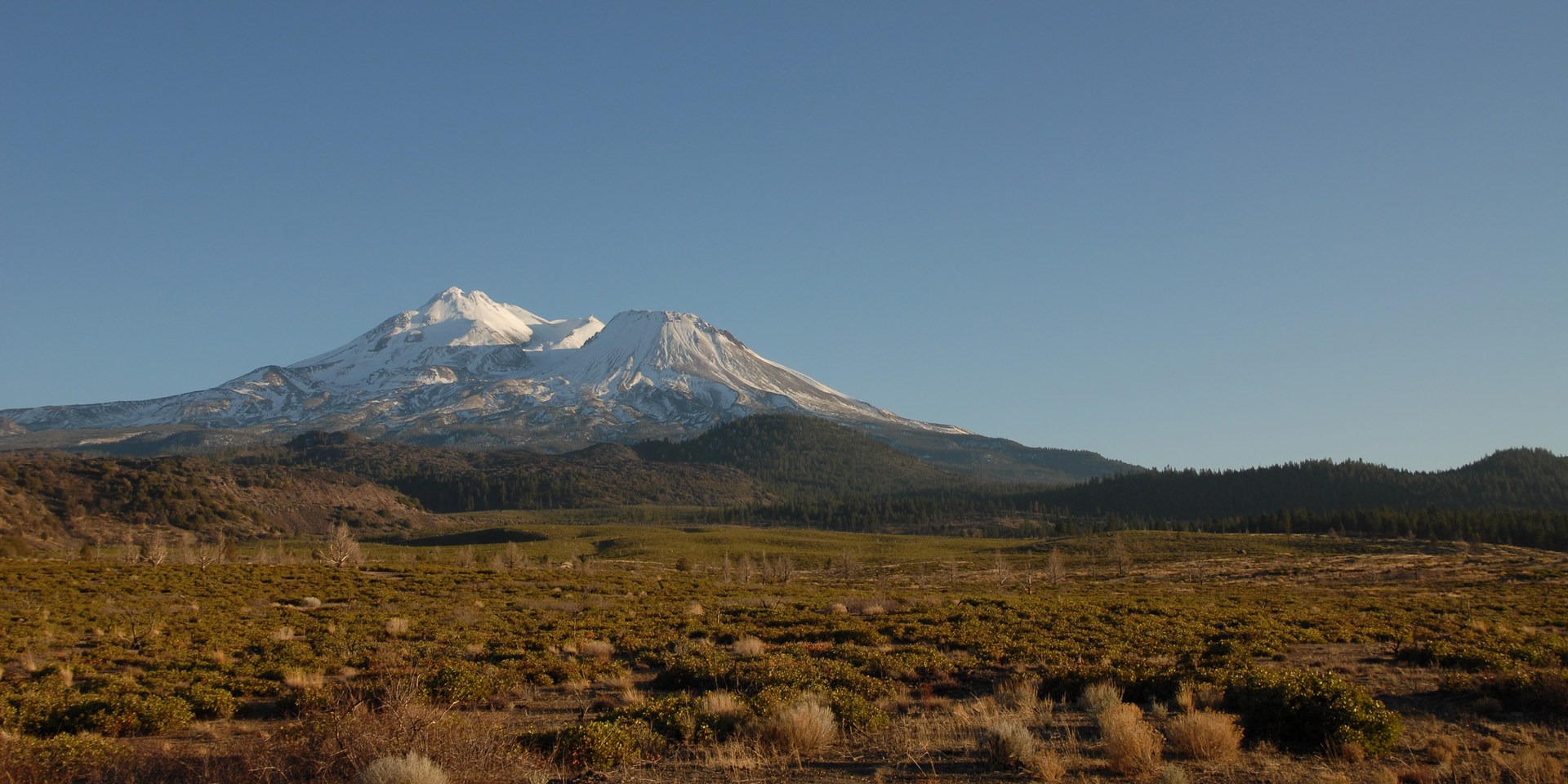You are here
Everyone Wants More | The Water We Can't See | Can We Find More Water? | Fixing Water Isn't Easy | And The Drought Continues | Learn More
This is the third piece of a four-part series on the Sacramento River watershed. The first piece discusses people in the watershed, the second discusses water rights, and the final piece discusses conservation.
Everyone Wants More
The challenges facing the Sacramento watershed are as varied as the streams that flow into it. From wildfires to bark beetle infestation, water diversions and drought, consensus across the spectrum of issues is difficult to find. Fingers point in all directions, generally with an individual water user’s priorities taking precedence in their mind, even if it conflicts with another’s. Logging, oil industry usage, agricultural use, and environmental groups seeking to protect wildlife compete for the state’s limited supply of water, a fight exacerbated by water diversion projects that deliver water from the Sacramento watershed to Southern California.
From the very beginning in California, the rugged individual eking out a living from a wild landscape has been a powerful archetype. Agriculture dominated the landscape, from early farmers making use of fertile valleys to sheep and cattle ranchers ranging their herds. Water rights history has created a legacy of conflict affecting old and new interests alike. Whereas only 93,000 people lived in the city of Sacramento in 1930, now that number is over five times bigger. There are 485,000 people in the area who need household water, food, and places to recreate. Just the increase in human use would be a strain on the system in normal years. Unfortunately for Californians, we are no longer in a normal set of circumstances. Surface water is becoming more scarce as less snow falls on the Sierra Nevada. Less water in the hills means less water moves through the watershed. With greater demand for water, less is left to seep deep into the earth, recharging the region’s aquifers as it passes.
One thing is for certain: As climate change continues unabated and we continue to dither about what changes in our collective actions are needed globally, the effects are being felt on the local scale. Even after benefiting from a tremendous amount of precipitation from this year’s El Niño effect, California is no closer to full relief from drought. Scientific studies in the Sierra Nevada show that the snowfall in 2016 is not enough to overcome a water deficit that could last potentially until 2019. After what has already been years of drought, three more years seems long indeed. The major water user groups of agriculture, humans, environment, and oil and gas all feel compelled to protect the water that they currently access.

The Water We Can't See
Groundwater stored in aquifers has become critical as a stopgap in water-short years, though recent improvements to regulating groundwater use may reduce the dependence of primary users like agriculture. Added requirements that newly formed local groundwater management agencies must provide a 20-year management plan are being hammered out, and there is still a wide degree of flexibility in the wording of the document. According to the water watchdog website Circle Of Blue, allowing for “substantial compliance” would give local agencies a loophole to avoid the mandates and monitoring that aquifers need most. And agriculture users are not the only people making copious use of the underground resource. The oil industry’s hydraulic fracturing processes are coming under fire as many environmentalists raise concerns over the contamination of crucial underground water supplies. Currently, thousands of the 84,000 hydraulic fracturing wells in the state are in violation of the Safe Drinking Water Act for the toxic fluids they illegally inject into aquifers. While petroleum spokespeople claim drinking water is not being adversely affected, overall groundwater pumping accounted for up to 65% of water used in California in 2014, while in a typically wetter year it accounts for 30%. This means that any groundwater contamination, however small, can have huge ramifications as aquifers disperse water over vast areas.
Toxic chemicals are only one threat to groundwater. Since 2011, land in some areas has been sinking at a rate of over a foot per year because of groundwater removal, much of it being used opaquely for agricultural purposes. Farmers are forced to drill deeper and deeper each year in order to reach the water table. As the water table moves lower, the layers above compact, consolidating and making future water storage less likely. The newest groundwater regulations have faced stiff resistance from the farm lobby, which claims that it will hurt the ability of farms to adequately water crops.
Can We Find More Water?
The lengthening drought has elicited some eyebrow-raising ideas for finding more water. One idea that has surprising traction is the concept of logging for water. With years of fire suppression and the resulting overcrowded single-age stands of forest land, an argument is being made that cutting or thinning the trees will free up groundwater used by those trees, allowing it to flow downstream. UC Merced’s Sierra Nevada Research Institute is pushing the concept with the support of The Nature Conservancy. In a joint report between the institute and The Nature Conservancy, it was claimed that thinning and cutting in sufficient amount would improve “[t]he forest’s ability to store snow and use water more efficiently." The research has resulted in the bill AB 2480 which has been presented to the California legislature for approval in support of these claims.
Numerous water management agencies are skeptical of the bill because it would require consumers to pay for the logging with little to no guaranteed benefit. Some see it as an outright ploy to allow private industry to profit from the water conflicts. Indeed, environmental restoration and repair may be necessary after these “beneficial cuts,” costing taxpayers money and reducing the quality of these federal natural areas. To put it in perspective, a countering study done by hydrologist Jonathan Rhodes and fisheries biologist Christopher Frissell claims that in order to meet the potential water recovery numbers, as much as 25% of the forest in a given watershed would need to be clearcut every 10 years in order to meet the threshold. Their study was commissioned by Environment Now, a private environmental foundation. Outdoors enthusiasts would find it close to impossible to support such a drastic approach. The experiences of hiking, mountain biking, and fishing on these lands would all be altered to such an extent as to be unrecognizable.
The impacts of logging in the Sacramento watershed have come under scrutiny in one of the most important habitats for endangered Sacramento River winter-run Chinook salmon. Battle Creek, located on the flanks of Mount Lassen, is a year-round cold water stream that provides the ideal temperatures for baby Chinook to survive. Over $125 million from state and federal restoration efforts have gone to improving and restoring this tiny watershed, second in cost only to the Elwha Dam removal project. However, aggressive upstream logging has hampered these efforts, where massive clearcuts have been the norm for decades. Winter-run Chinook salmon traditionally swam in the McCloud, Pit, and Little Sacramento Rivers and Battle Creek, but dam construction put an end to populations that lived above the Shasta and Keswick Dams. The current restoration work being done in Battle Creek would restore 42 miles of streambed and 6 miles of tributary. Water quality both in temperature and cleanliness is imperative for these salmon to survive in spite of the challenges they face. Having the necessary cold water during hot summer months, in a state enduring years of drought, is no easy task, and winter-run Chinook are not the only species in peril whose water needs are often superseded by human uses.
Fixing Water Isn't Easy
Downstream, miles away from where the cold waters of Battle creek combine with the Sacramento River, salmon and delta smelt face additional threats in the pending Delta Waters Tunnel Project known as California Waterfix. The WaterFix project would build two massive tunnels to pump water exports to protect drinking water and minimize the effects of sea level rise expected with continued climate change. The project has received much critical press because, while it will not actually increase water exports, it will maintain current levels. The touted benefits of improved water access are doubted, especially in concert with the potential environmental effects.
At present, the pumps currently in use on the delta reverse the flow of water, putting endangered and threatened species at risk. While the new tunnels would seek to prevent this, the intake points slated to be built outside of Hood, California, could pose an entirely new threat to salmon and fish living near them. There is also the rising concern that more water will be pulled from the delta, further exacerbating the troubles of the watershed. Upstream management practices have already had severe consequences where the Sacramento River meets the bay.
On the nearby San Joaquin River, the State Water Resources Control Board is set to release their water quality plan that could have a big impact on the flow of fresh water through the delta. Freshwater flows may see a dramatic increase as part of a larger plan for restoring fish numbers in the delta. To do so, senior water rights users like upstream agricultural regions and some major cities could be forced to reduce their take. While the change could harm some, the increased San Joaquin River flow could reduce the amount of time the current pumps sit idle when endangered species are threatened. Less downtime could allow more water to be provided to users.
California's Water Resource Board will draft up water quality plans for the Sacramento and the delta at a later date. The WaterFix project might not survive the increased flow requirements of these new plans. If built, the new delta tunnels would have to adhere to the same rules, reducing the amount of water delivered to water districts and making the project financially untenable. Efforts to increase water flow for protection and enhancement of endangered species come under heavy scrutiny by major groups like agriculture and municipal water users. "Wasted water" used to improve fish habitat and boost endangered species populations could be better used for human consumption, so the argument goes, especially during a drought.
And The Drought Continues
Drought is nothing new to the region. Prior droughts of 10 to 20 years have been documented in tree rings (among other things) during the previous 1,000 years. In a region where precipitation values are more varied than anywhere else in the Lower 48, the consequences of multiple dry years in a row can be devastating and difficult to accommodate. During the drought that lasted from 1976 through 1977, Californians made their first concerted push for statewide water conservation. More recently, California Governor Jerry Brown mandated a 25% reduction, a restriction that has only been slightly loosened. Communities can now set their own water usage goals, allowing areas that received more water this past winter to increase their usage a bit.
A slight reprieve is unfortunately not enough to make statewide impact, and the debate continues unabated over future water usage. The conflicts become immediately apparent when you begin to review who is using the watershed’s bounty, and for what.
From encouraging small salmon fry through these harrowing circumstances to rehabilitating meadowlands, several organizations are working hard to protect and mitigate against the challenges currently facing the Sacramento watershed. This work will be the focus of next piece, the fourth and final installment of the series.
Learn More
For more information about the Sacramento watershed, follow the rest of the series here:





Comments
Sign In and share them.